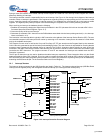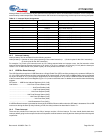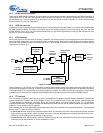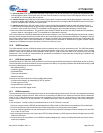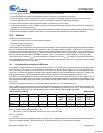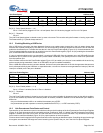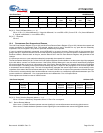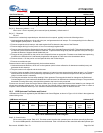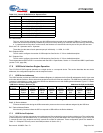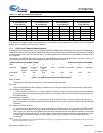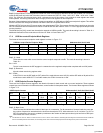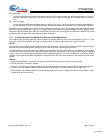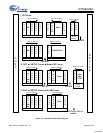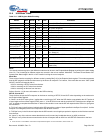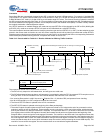
CY7C65113C
Document #: 38-08002 Rev. *D Page 33 of 49
Bit [0..3] : Resume x (where x = 1..4).
When set to 1 Port x requesting to be resumed (set by hardware); default state is 0.
Bit [4..7] : Reserved.
Set to 0.
Resume from a selectively suspended port, with the hub not in suspend, typically involves the following actions:
1. Hardware detects the Resume, drives a K to the port, and generates the hub interrupt. The corresponding bit in the Resume
Status Register (0x4E) reads ‘1’ in this case.
2. Firmware responds to hub interrupt, and reads register 0x4E to determine the source of the Resume.
3. Firmware begins driving K on the port for 10 ms or more through register 0x4B.
4. Firmware clears the Selective Suspend bit for the port (0x4D), which clears the Resume bit (0x4E). This ends the hardware-driv-
en Resume, but the firmware-driven Resume continues. To prevent traffic being fed by the hub repeater to the port during or
just after the Resume, firmware should disable this port.
5. Firmware drives a timed SE0 on the port for two low-speed bit times as appropriate. Firmware must disable interrupts during
this SE0 so the SE0 pulse isn’t inadvertently lengthened, and appear as a bus reset to the downstream device.
6. Firmware drives a J on the port for one low-speed bit time, then it idles the port.
7. Firmware re-enables the port.
Resume when the hub is suspended typically involves these actions:
1. Hardware detects the Resume, drives a K on the upstream (which is then reflected to all downstream enabled ports), and
generates the hub interrupt.
2. The part comes out of suspend and the clocks start.
3. Once the clocks are stable, firmware execution resumes. An internal counter ensures that this takes at least 1 ms. Firmware
should check for Resume from any selectively suspended ports. If found, the Selective Suspend bit for the port should be
cleared; no other action is necessary.
4. The Resume ends when the host stops sending K from upstream. Firmware should check for changes to the Enable and
Connect Registers. If a port has become disabled but is still connected, an SE0 has been detected on the port. The port should
be treated as having been reset, and should be reported to the host as newly connected.
Firmware can choose to clear the Device Remote Wake-up bit (if set) to implement firmware timed states for port changes. All
allowed port changes wake the part. Then, the part can use internal timing to determine whether to take action or return to
suspend. If Device Remote Wake-up is set, automatic hardware assertions take place on Resume events.
16.5 USB Upstream Port Status and Control
USB status and control is regulated by the USB Status and Control Register, as shown in Figure 16-10. All bits in the register are
cleared during reset.
.
Bits[2..0]: Control Action
Set to control action as per Table 16-2. The three control bits allow the upstream port to be driven manually by firmware.
For normal USB operation, all of these bits must be cleared. Table 16-2 shows how the control bits affect the upstream port.
Hub Ports Resume Address 0x4E
Bit # 76543210
Bit Name Reserved Reserved Reserved Reserved Resume 4 Resume 3 Resume 2 Resume 1
Read/Write - - - - R R R R
Reset 00000000
Figure 16-9. Hub Ports Resume Status Register
USB Status and Control Address 0x1F
Bit # 76543210
Bit Name Endpoint
Size
Endpoint
Mode
D+
Upstream
D–
Upstream
Bus Activity Control
Action
Bit 2
Control
Action
Bit 1
Control
Action
Bit 0
Read/Write R/W R/W R R R/W R/W R/W R/W
Reset 00000000
Figure 16-10. USB Status and Control Register
[+] Feedback



